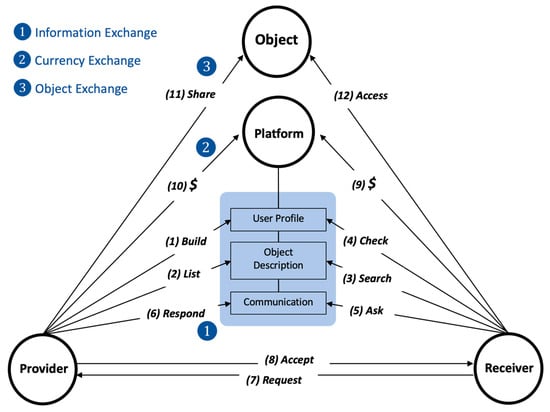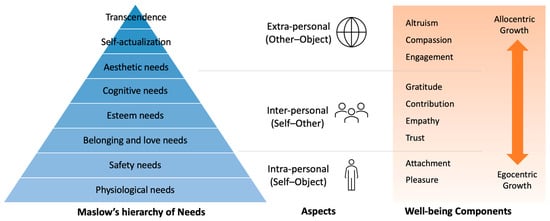To regain overall well-being in the post-pandemic era, the priorities should not be only economic growth but also human physical and mental health.
- well-being
- circular economy
- peer-to-peer platform
- collaborative consumption
- product–service system
1. Introduction
2. The Peer-to-Peer Sharing and Reuse Platform

3. How the Concept of Well-Being Works in Sharing and Reuse Contexts

|
Aspect |
Component |
|---|
- 51], etc.
Definition | Examples |
|---|
- Attachment: This is the close bond developed between a baby and a mother (or a caregiver) through which the baby feels connected and secure [31][52]. In the sharing and reuse context, attachment can be extended toward inanimate things, such as an object or an environment. A strong attachment to an object motivates people to take good care of it and increases well-being [32][53]. Sellers who have a higher attachment to used products are more likely to offer discounts to buyers who will be able to use them appropriately [33][54]. For example, the presence of personal objects that evoke perceptions of the host’s presence can improve guests’ attachment to their hosts
- [
|
Attachment |
A close bond between a baby and a caregiver to feel connected and secure [31][52]. |
Sharing accommodation [35][56], personal items [34][55], etc. |
|
|
Inter- personal |
Trust |
An attitude in which a person believes and relies on one another to behave as expected in an uncertain and vulnerable situation [36][57]. |
Sharing accommodations [13][14][16][40][41][42][43][44][35,36,38,61,62,63,64,65], vehicles [82][103], information, knowledge [83][][10484,105], etc. |
|
Empathy |
A mental process in which emotions are elicited by others’ traits and conditions, and the reasons behind these emotions [46][67]. |
Sharing accommodations [48][69], vehicles [49][70], information [50][51][71,72]., etc. |
|
|
Contribution |
A positive impact on others that fulfills one’s human needs of autonomy, relatedness, and competence [52][73]. |
||
|
Gratitude |
- Trust: This can be defined as an attitude in which a person relies on and believes another to behave as expected in an uncertain and vulnerable situation
-
Intra-personal: The well-being components are experienced within the self or with an inanimate object. The affective experience is independent of the presence of others, such as pleasure and attachment toward an object, which can be a product or service, tangible or intangible.
-
Inter-personal: The well-being components depend on the interaction between the self and others. Through a P2P platform, users exchange and communicate with each other and experience positive affects (e.g., trust, empathy, gratitude).
-
Extra-personal: The well-being components are transcendent concerns or actions for goods, beings, and cosmos beyond the self. In such an experience, one feels the unity of all things and aims to fulfill one’s full potential (e.g., engagement, compassion, and altruism).
-
Pleasure: This is a positive influence that is fundamental and essential to the perception of well-being [23][44]. The need for pleasure ensures that animals are attracted to food, sex, or social interactions, leading to survival and reproduction [24][45]. Since owning and sharing possessions induces pleasure, scholars emphasize sharing and reusing rather than owning in the new era [25][46]. In addition, sharing tangible and intangible things generates pleasure. For example, sharing food online and offline facilitates social connections, and increases pleasure [26][27][47,48] and the appeal of food [27]
A feeling of thankfulness when one receives favors, kindness, help, and support from others | |||
[ | |||
] | |||
[ | 77]. |
Sharing word-of-mouth [61][82], comments [62][83], sale information [63][84], etc. |
|
|
Extra- personal |
Engagement |
A state of being immersed in an activity or experience, and the optimal condition can be called a “flow” [64][65][85,86]. |
|
|
Compassion |
A caring attitude and willingness to help others who are suffering [70][71][91,92]. |
||
|
Altruism |
A behavior rather than an emotion, which benefits others at the expense of oneself [76][97]. |
Sharing knowledge, expertise [78][79][80]][99,100,101[81,102], etc. |
- ]
- . Trust allows people to perceive security, support, and comfort, and facilitates pro-social behavior
- [37][58]. It plays a crucial role in P2P platforms [38][39][59,60], where users share belongings with strangers, especially while sleeping at others’ homes [40][41]62[42],63[43],64[44][61,,65]. Möhlmann and Geissinger [45][66] identify six design features that establish trust in the sharing economy: peer reputation, digitalized social capital, information provision, escrow services, insurance cover, and certification/external validation. Additionally, one study indicates that the quantity of information and communication between a provider and a receiver [44][65], the duration of self-description and diversity of topics of hosts in self-disclosure [14][36], and the humanization of profile pictures [16][38] are important factors to build trust. Moreover, the trustworthiness of the host’s personal photo increases the listing price and the probability of its being selected [13][35].
-
Empathy: This is regarded as the mental process of eliciting emotions in response to others’ traits and conditions, as well as understanding the reasons behind these emotions [46][67]. Empathy is an emotional response based on the perception of others’ well-being [47][68]. In the sharing and reuse context, the empathy of receivers toward providers increases their willingness to make a purchase [48][69]. In addition, business and personal information disclosures between a seller and a buyer have a positive impact on empathy and business performance [49][70]. There is evidence that empathy prevents customers from leaving negative reviews [50][51][71,72].
-
Contribution: The concept of contribution refers to a person’s positive impact on others and their fulfillment of the basic psychological needs of autonomy, relatedness, and competence [52][73]. It can strongly predict the eudemonic well-being of oneself [53][74]. Concerning the sense of contribution in the sharing and reuse context, self-worth serves as an important intrinsic motivation to promote sharing of mobile coupons in social media [54][75]. Another study has shown that an organizational sense of contribution positively correlates with the intention of information system personnel to share knowledge [55][76].
-
Gratitude: This is a feeling of appreciation when one receives favors, kindness, help, and support from others [56][77]. One can feel gratitude for not only inter-personal relationships but also for an object or an experience, such as artwork or a trip [57][78]. Research shows that practicing gratitude improves well-being (e.g., [58][59][60][79,80,81]). Gratitude appeal encourages word-of-mouth for sustainable luxury brands [61][82]. Furthermore, posting grateful reviews of firms will encourage other consumers to reward firms [62][83]. The gratitude between a salesperson and customer fosters the prosocial behaviors (e.g., information sharing) of a salesman, thus developing long-term buyer–seller relationships [63][84].
-
Engagement: This refers to the state of being immersed in an activity or experience. It is also regarded as an optimal experience, “flow” [64][65][85,86]; moreover, it is defined as an exceptional and enjoyable experience that leads to the attainment of well-being [66][87]. Scholars indicate that a sense of ownership is the antecedent to engagement, including loyalty to a brand (or platform), contributions to its reputation, service functionality, and community-oriented sharing [67][88]. Additionally, inter-personal contamination (e.g., bad hygiene, intrusion of privacy) has negative effects on engagement in accommodation sharing, but the authenticity (e.g., providing more information about hosts, sharing their living space, and building a closer relationship between the host and the guest) can alleviate these negative effects, improving the engagement in sharing experiences [68][69][89,90].
-
Compassion: This is an attitude of caring for others and a willingness to assist them in their suffering [70][71][91,92]. Additionally, treating oneself, others, and the environment with compassion improves individuals’ well-being and mental health [71][72][73][92,93,94]. Empathy and compassion are fundamental for the prosperity of social relationships. Furthermore, compassion enables people not only to share others’ emotions but also to help others [74][95]. According to a study, people who have high levels of trust and compassion for others are significantly more willing to share shelters and vehicles following disasters. In addition, the role of people (volunteers in past disasters and members of community organizations) rather than idle resources influences willingness to share [75][96].
-
Altruism: This is regarded as a behavior rather than an emotion that gives benefits to others at the expense of oneself [76][97]. Altruism is based on empathy and compassion [47][77][68,98], which encompasses both inter-personal and extra-personal actions. In the sharing context, altruism and trust attract considerable attention. There is evidence that trust improves knowledge-sharing intentions, and altruism has a positive impact on the relationship between trust and knowledge-sharing intentions in teacher communities [78][99]. In particular, the trait of altruism impacts sharing intentions and lowers the need for trust [79][100]. Volunteers for the Wikipedia Foundation found that altruism motivates them to contribute to society continuously [80][81][101,102].
